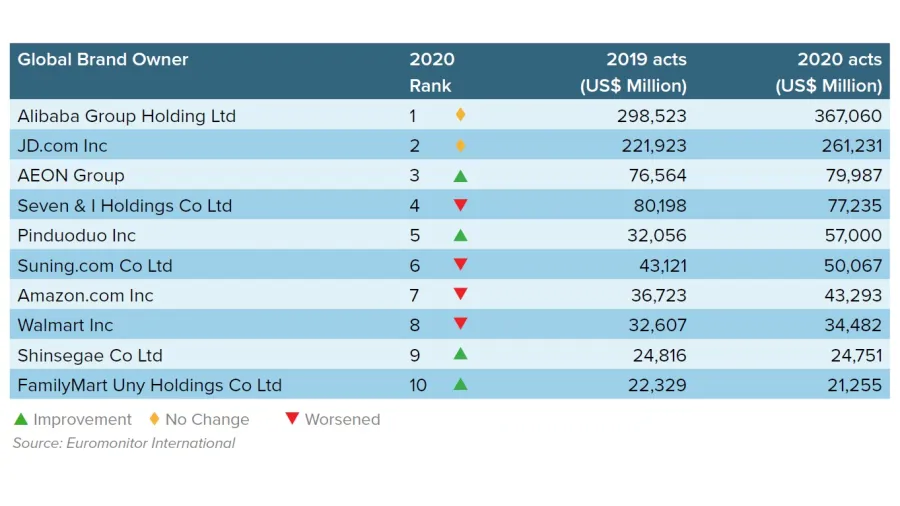
Alibaba ranks first in Top 100 APAC Retail Ranking 2021: study
The Asia Pacific region recorded a double digit-growth in e-commerce in 2020.
Alibaba Group Holding Ltd. achieved the top spot with actuals amounting to $367.06b in 2020, according to Top 100 Retailers in Asia 2021. JD.com Inc. nabbed the number two spot with $261.23b, followed by AEON Group with $79.99b.
Other retail firms completing the Top 10 from the list are Seven & I Holdings Co Ltd., Pinduoduo Inc., Suning.com Co Ltd., Amazon.com Inc., Walmart Inc., Shinsegae Co Ltd., FamilyMart Uny Holdings Co Ltd.
Senior research analyst at Euromonitor Deepika Chandrasekar said “We’ve experienced truly unprecedented times, with the pandemic’s ramifications felt across many industries including Retailing. But to be honest, the players that emerged as the Top 10 retailers in 2020 come as no surprise because of the commonality underlying all of them – all 10 retailers play in categories including e-commerce, grocery retail (like supermarkets, hypermarkets, convenience stores), department stores, or drugstores,” she said.
“Most of these categories have witnessed either positive growth or managed to dodge a severe blow in 2020. This is thanks to the shift in consumer behaviour towards online shopping, stocking up of groceries for home-cooking, a renewed sense of health and wellness, and a heightened desire for convenience,” she added.
Chandrasekar said Chinese companies continue to top the list because of their adaptability to the consumers and their continuing strong presence in e-commerce.
“There were no significant changes in ranks among the top 10 players compared to 2019, except for China’s largest agriculture-based e-commerce platform Pinduoduo, which saw a jump of three ranks to the fifth place among Asia’s Top 100 retailers, due to its enticing team purchase business model,” she said.
“In general, Chinese giants like Alibaba and JD.com unsurprisingly continue to dominate the region’s e-commerce, owing to their robust ecosystem, large domestic consumer base, easy user interface, and various payment options,” she added.
Key Retailing Categories
Among the categories in retail that survived the changes brought by the pandemic include Grocery Retailers, Non-Grocery Specialists and Mixed Retailers, and E-Commerce.
The study observed that grocery sales experienced a surge in 2020 as food consumption shifted to homes. To an extent, there has been a number of consumers in some markets that stockpiled items in preparation for home seclusion. Benefitting from this behavior are large store-format players AEON Group, Auchan Group, and Yonghui Superstores Group.
The opposite, however, was experienced in Indonesia, South Korea, and Thailand as consumers turned to online platforms for essentials instead of brick-and-mortar grocers. This negatively impacted grocery retailers in the said countries, whilst e-commerce retail value sales expanded by 53%, 23% and 69%, respectively.
New strategies are seen to emerge due to these changes, such as drive-throughs and curbside pick-ups. The study suggests that store-based grocery retailers explore ways to create touchpoints with consumers to adapt to the consumers who have grown accustomed to shopping via online channels.
For Non-Grocery Specialists and Mixed Retailers, it was observed that consumers have shifted to products that complement and help improve their lifestyle. AEON Group benefited from this change, particularly with an increase in demand for hygiene products and daily brands through their health and beauty retail brands Welcia and Tsuruha.
Due to store closures and in-store traffic drops, Non-Grocery Specialists and Mixed Retailers in APAC declined by 14% in 2020. These retailers are now positioning themselves as lifestyle destinations to gain traction from consumers. Shinsegae Co Ltd in South Korea continues to routinely transform their Busan Centum City flagship store by integrating a spa, cinema, and art exhibition in their space.
For E-Commerce, food and drink e-commerce performed strongly as consumers ordered daily necessities and grocery items. Agriculture-focused Chinese e-commerce platform Pinduoduo recorded a growth of 78% in value sales with its innovative team-purchase business model.
Brands are likewise turning to social commerce, utilising live streaming, gamification and online influencers to reach and engage with consumers.
Similarly, premium and luxury products were also seen to gain traction through online purchasing. Alibaba introduced its “Luxury New Retail” initiative in 2020 to transform the luxury shopping experience.
Shopee, a Southeast Asian e-commerce platform owned by Sea Ltd., introduced “Shopee Premium” which offered a curated list of international brands. Here, they featured and supported the brands by offering an avenue for product launches, exclusives, and reviews.
Another important point observed is the rising popularity of mobile wallets in Southeast Asia, where many consumers remain unbanked or underbanked. This market is expected to help accelerate regional e-commerce growth if tapped accordingly.
The study projects that e-commerce in APAC will continue to grow, mainly driven by young and tech-savvy consumers. Companies that are able to adapt and integrate the whole experience from product discovery to fulfillment are seen to be in the best position to benefit from this shift in behavior.

















 Advertise
Advertise







